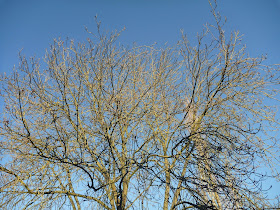Louise Bourgeois, in Artist Rooms, at Tate Modern, Switch House.

This exhibition brings together a selection of Bourgeois' late works, alongside a small number of earlier pieces from her remarkable seven-decade career. She returned again and again to a number of themes, though the materials she used to express them vary greatly. Her long term interest in textiles was sparked by her parents' business restoring antique tapestries. Her sculpture, drawing and writing are characterised by an unflinching emotional honesty, as she continually retold and reworked the memories and stories that shaped her life. Her work is often autobiographical, while addressing universal experiences such as birth, death, love, loss and fear.

Spider, 1995, (bronze, dark and polished patina, wall piece)
During the 1990s Bourgeois made a number of spider sculptures. She associated the spider with her mother who spent her days weaving and stitching as she repaired antique tapestries for the family
business. She explained:
'I came from a family of repairers. The spider is a repairer. If you bash into the web of a spider, she doesn't get mad. She weaves and she repairs'.
Untitled, 2010, (fabric, thread, rubber, stainless steel, wood and glass)
This vitrine could be seen as a kind of self-portrait. A reclining, multi-breasted torso is made from a stuffed woollen blanket that belonged to the artist and a number of berets that she wore throughout her life. A pole with spools of thread and a black hanging drop-shaped object - a repeated form in Bourgeois' sculptures - reflect the artist's interest in memory, restoration and reparation.
looking closer
Untitled, 1946-47 (oil on canvas)
This painting was made at an early point of Bourgeois' career when she lived in a Manhattan apartment building. As a young mother, Bourgeois found freedom from the claustrophobia of her domestic situation by using the roof space as a studio. The figure in the foreground with long hair swirling in the sky is likely to represent the artist herself while the figures on the chimney behind her may be her three young sons.

Untitled, 1996, (cloth, rubber, steel and mixed media)
In the 1990s Bourgeois began to incorporate clothing into her sculptures - these garments had belonged to her mother and herself, and some were from her childhood. In a series of pole pieces, she hung the garments from bones as well as hangers. The discarded clothes appear as relics from her past lives as daughter, wife and mother, while bringing into sharp focus the situation of the ageing body. The bones here also act as a kind of memento mori or reminder of the inevitability of death.
Cell XIV, (Portrait), 2000
For Bourgeois, the three-headed state is one of confusion, ambivalence and hysteria - as if the figure were being torn in different directions. Three was a significant number for Bourgeois as she was the middle child of three and she herself had three children.
looking closer
Single II, 1996, (fabric, hanging piece)
Bourgeois produced a large series of soft sculptures in her later years, making use of textiles and old clothing that she had kept for decades. This headless suspended figure made of stuffed fabric is posed in the 'arch of hysteria', a position expressing an extreme state of tension and pain documented by the 19th century neurologist Jean-Martin Charcot.
a different view
Legs, 2001, (red fabric, hanging piece)
view from a different angle
The couple represented here appear to merge into each other. As in many of Bourgeois' works, male and female are combined in an ambiguous arrangement of body parts. For Bourgeois hanging indicates a state of uncertainty. 'Horizontality is a desire to give up, to sleep', she said. Verticality is an attempt to escape. Hanging and floating are states of ambivalence'.
a different view
Spider, 1994, (bronze, silver nitrate and brown patina, and granite)
This large-scale bronze spider carries a granite egg in her sack, revealing Bourgeois' interest in the creature as an image of the strong mother: protector, creator and repairer. In 1995 Bourgeois wrote a poem about her mother who died when the artist was young. She compares her to a spider,
'because my best friend was my mother and she was deliberate, clever, patient, soothing, reasonable, dainty, subtle indispensable, neat and useful as an araignee (spider). She could also defend herself, and me....'
looking at the sack and the egg
In a smaller room smaller sculptures were displayed in vitrines:
Untitled, 1999 (fabric, wood and metal)
Pregnant Woman, 2003, (fabric and stainless steel)
The Woven Child, 2002, (fabric, steel and aluminium)
Untitled, 2009, (fabric and wood)
Nature Study No. 1, 1985, (bronze, dark and polished patina)
Untitled, 2004, (fabric and stainless steel)
Knife Figure, 2002 (fabric, steel and wood)
Femme Couteau, 1982, (black marble)
Give or Take, 2002, (bronze, silver nitrate patina)
Femme, 2005, (bronze, silver nitrate patina)
Couple, 2004, (fabric and stainless steel)
Fallen Woman, 1981, (bronze black patina)
Fillette (Sweeter Version), 1968-99, cast 2001 (latex over plaster)
The title of this phallic sculpture means 'little girl', and ironic disjunction of word and object. Bourgeois has talked about this work in relation to her experiences as a wife and a mother to three boys, which led her to see masculinity as far more vulnerable than she had imagined.
'From a sexual point of view I consider the masculine attributes to be extremely delicate', she explained.
'They're objects that the woman, myself, must protect'.
The photographer Robert Mapplethorpe famously portrayed Bourgeois with a version of this work tucked playfully under her arm.























































